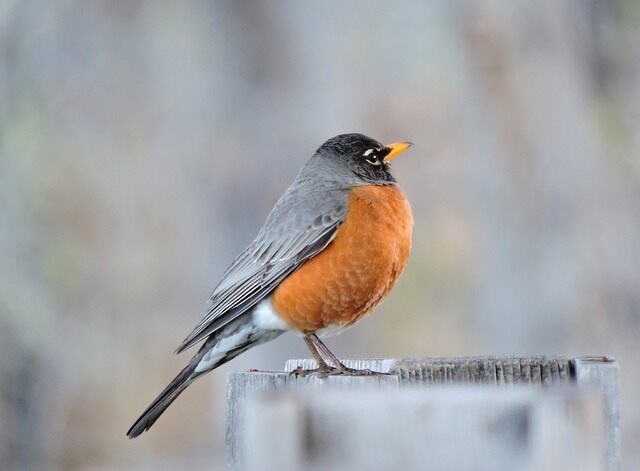Embark on a winter birdwatching adventure in Tennessee with our expert guide featuring 19 backyard bird species! From the vibrant Northern Cardinal to the melodious Carolina Wren, Tennessee’s landscapes teem with avian activity during the colder months.
In this comprehensive guide, we’ll uncover the unique characteristics, habitats, and behaviors of these winter residents, offering valuable insights for birdwatchers and nature enthusiasts alike.
Table of Contents [show]
Backyard Winter Birds in Tennessee
(Species observed from December through February.)
Northern Cardinal
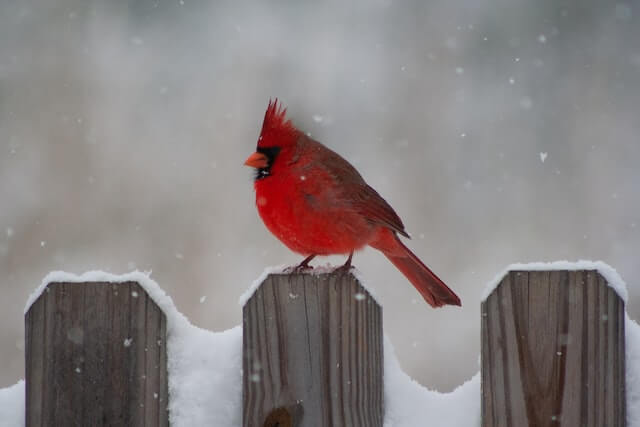
- Length: 8.3-9.1 in (21-23 cm)
- Weight: 1.5-1.7 oz. (42-48 g)
- Wingspan: 9.8-12.2 in (25-31 cm)
- Scientific Name: Cardinalis cardinalis
- Frequency of Occurrence: 57.76%
- Maps: Range Map – Sightings Map
- Sounds: Calls and Sounds
- Where To Find Them: In Tennessee, they are common in the mountains near Knoxville and Chattanooga, as well as along the eastern edge of the state.
- How to Attract Them: They are attracted to a variety of feeders, but one of the best ways to attract them is by using a platform feeder with safflower, black oil sunflower seeds, and milo.
General Information: The Northern Cardinal (Cardinalis cardinalis) is a beautiful songbird that is native to North America. Its range extends from southern Canada down to Central America. It is most common in the eastern half of the United States, but its range includes parts of Mexico and the Caribbean. The cardinal prefers wooded areas, but can also be found in suburbs and other habitats.
In terms of food, cardinals are omnivorous, meaning that they eat both plants and animals. They mainly eat seeds, grains, and nuts, as well as insects, fruits, and berries. During the winter, they switch to a diet that mostly consists of seeds, which they can find in bird feeders, on the ground, or among plants.
They also enjoy suet, a type of animal fat, which provides them with extra energy when temperatures are cold. The Northern Cardinal is an important part of the North American ecosystem, providing food and shelter to other birds and animals. This species is also popular among birdwatchers, as it is easily spotted and has a beautiful, bright red plumage.
Related:
- 10 Best Bird Feeders for Cardinals (Rated for 2022)
- Best Birdhouse for Cardinals 2022 (Tested And Rated)
- Where Are Cardinals Found? Best Spots to Look!
Carolina Chickadee
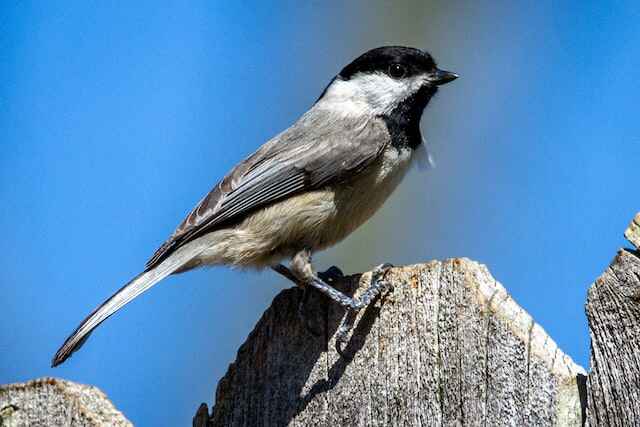
- Length: 4.7-6.0″ in (12.0-15.2 cm)
- Weight: 0.3-0.5 oz (9-14 g)
- Wingspan: 6.3-8.3 in (16-21 cm)
- Scientific Name: Poecile carolinensis
- Frequency of Occurrence: 50.03%
- Where To Find Them: They are most commonly found in areas near bodies of water, but they can also be found in other parts of the state. These birds are mostly active during the morning and evening hours, but they will also be seen flying around during the day.
- How to Attract Them: They are attracted to many types of food, but the best way to attract them is by using a tube style feeder with Black-oil sunflower seeds, safflower, or peanut pieces.
General Information: The Carolina Chickadee (Poecile carolinensis) is a small songbird native to the southeastern United States. It is found from the mid-Atlantic states south to northern Florida and west to central Texas. Its range also extends as far north as southeastern Minnesota in the summer months. It prefers open woodlands, deciduous forests, and suburban habitats. They are also commonly found in orchards, parks, and gardens.
The Carolina Chickadee primarily feeds on insects, such as caterpillars, moths, and beetles, as well as spiders and other small arthropods. They also feed on a variety of seeds, nuts, and berries. They are known to visit bird feeders, where they will eat sunflower seeds and other birdseed. In the summer, they may also feed on flower nectar and sap from trees.
The Carolina Chickadee is a frequent visitor to bird baths, where it will bathe and play. The Carolina Chickadee is a year-round resident in its range, but some birds may travel south for the winter. They will often join mixed-species flocks of other songbirds, such as titmice, woodpeckers, and warblers.
Read more about this bird: Carolina Chickadees – 9 Best Ways To Attract Them Fast!
Carolina Wren

- Length: 4.7-5.5 in (12-14 cm)
- Weight: 0.6-0.8 oz (18-22 g)
- Wingspan: 11.4 in (29 cm)
- Scientific Name: Thryothorus ludovicianus
- Frequency of Occurrence: 43.90%
- Maps: Range Map – Sightings Map
- Sounds: Calls and Sounds
- Where To Find Them: Carolina Wrens are found throughout the state of Tennessee, but they are most commonly found in moist areas such as streamsides and wet meadows. They can also be found in suburban areas, though they are less common there.
- How to Attract Them: If you are looking to attract the Carolina Wren, a small bird that is known for its beautiful songs, a platform feeder with mealworms, sunflower seeds, or peanut pieces can be a great way to do so.
General Information: The Carolina Wren (Thryothorus ludovicianus) is a small, vocal songbird found throughout the eastern and southeastern United States, as well as in parts of Mexico and Central America. The species’ natural range extends from New Jersey and Illinois south to the Gulf Coast and south Florida, and west to the eastern and central parts of Texas and Oklahoma. It is also occasionally seen in the extreme southwestern corner of New York.
Carolina Wrens are common in a variety of habitats, including woodlands, suburban gardens, and open grassy areas. They can often be seen in areas around human habitation, such as yards, parks, and even city streets. The Carolina Wren primarily feeds on insects, berries, and seeds. In the summer months, they will feed on caterpillars, beetles, grasshoppers, and other insects.
During the winter, they switch to a diet of berries, grains, and seeds. They are also known to eat small lizards, frogs, and even small snakes on occasion. Carolina Wrens will often visit bird feeders, particularly those that offer suet, peanut butter, and seeds. They will also often scavenge for food around outdoor grills and bird baths.
Read more about this bird: How to Attract Wrens to your Backyard? (Expert’s Guide!)
Tufted Titmouse
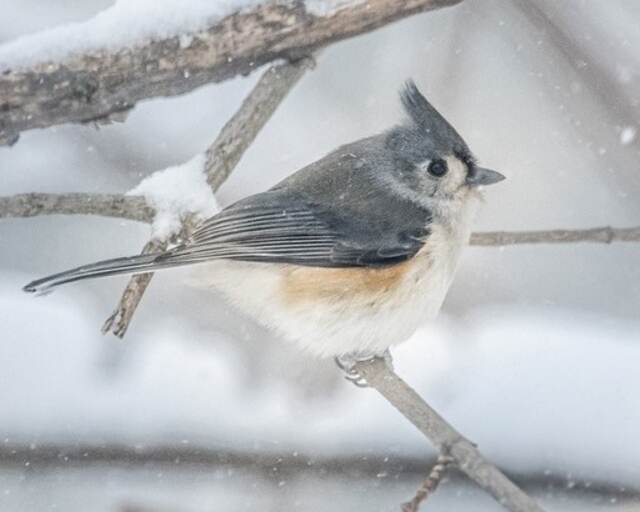
- Length: 5.5-6.3 in (14-16 cm)
- Weight: 0.6-0.9 oz. (18-26 g)
- Wingspan: 7.9-10.2 in (20-26 cm)
- Scientific Name: Baeolophus bicolor
- Frequency of Occurrence: 43.57%
- Maps: Range Map – Sightings Map
- Sounds: Calls and Sounds
- Where To Find Them: The tufted titmouse is a small bird that can be found in a variety of locations throughout Tennessee. These birds are common in areas with dense vegetation, such as the Great Smoky Mountains National Park. They are also common near water sources, such as rivers and marshes.
- How to Attract Them: One way to attract tufted titmice is to use a tube style feeder with black oil sunflower seeds or hulled sunflower kernels. The birds will find these feeds tasty and will come to your feeder often.
General Information: The Tufted Titmouse is a small bird found mainly in the Eastern United States and parts of Canada. Its range extends from the Atlantic Coast in Nova Scotia, Canada, to the Western side of the United States, from the Great Lakes to the Gulf Coast. The bird is commonly found in a variety of habitats, including deciduous and mixed forests, residential areas, and agricultural lands.
It prefers open areas with plenty of trees and shrubs, but can also be found in urban areas. The Tufted Titmouse is an omnivore, meaning it eats both plant and animal matter. Its diet consists of insects, seeds, nuts, fruits, and berries. It is also known to eat suet, peanut butter, bread, and other items offered at backyard bird feeders.
The Tufted Titmouse is an active bird that is often seen foraging in small groups. It moves quickly through the branches and twigs of trees and shrubs, searching for food. It is also known to feed on the ground, and will often visit bird baths to bathe and drink.
Read more about this bird: How to Attract Tufted Titmouse to my Yard? (Explained)
American Crow

- Length: 15.8-20.9 in (40-53 cm)
- Weight: 11.2-21.9 oz. (316-620 g)
- Wingspan: 33.5-39.4 in (85-100 cm)
- Scientific Name: Corvus brachyrhynchos
- Frequency of Occurrence: 43.55%
- Maps: Range Map – Sightings Map
- Sounds: Calls and Sounds
- Where To Find Them: The American Crow is a common bird in Tennessee. They are most commonly found near bodies of water, such as creeks and rivers. They also like to live near areas with lots of trees.
- How to Attract Them: They are attracted to a variety of food, such as black oil sunflower seeds or peanuts. Providing food in a platform feeder will help attract these birds and make them more visible to residents and visitors.
General Information: The American Crow (Corvus brachyrhynchos) is a large passerine bird native to North America. It is one of the most wide-ranging of the North American corvids, found from Canada and Alaska south to northern Mexico. It is a common bird found in a wide variety of habitats including urban parks, open fields, woodlands, and agricultural areas. The
American Crow is a highly adaptable species, and its range extends across much of the United States, including all of the continental states, most of Canada, and parts of Mexico. It is also found in parts of Hawaii and the Caribbean. The American Crow is also found in parts of Central and South America, including Costa Rica, Nicaragua, and Panama.
American Crows inhabit a variety of habitats, including open areas, farmlands, forests, and open water. They are also common in urban areas, particularly parks. American Crows are omnivorous birds, and their diet consists of a variety of foods, including insects, fruits, nuts, seeds, and carrion. They will also scavenge for food, such as garbage or leftovers from human meals.
Read more about this bird: How To Attract Crows To Your Backyard: Expert Tips!
Blue Jay
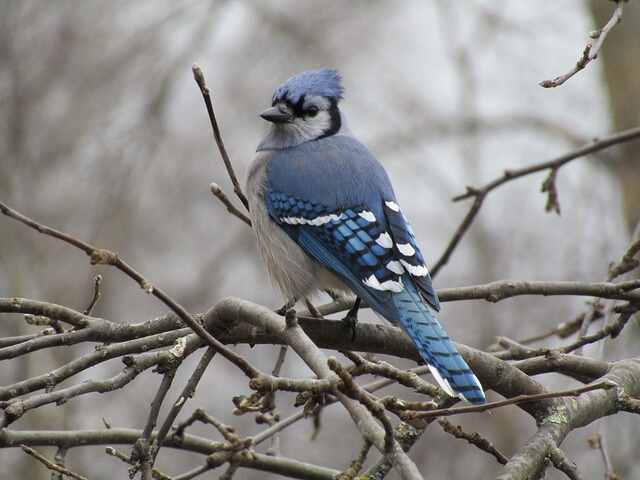
- Length: 9.8-11.8 in (25-30 cm)
- Weight: 2.5-3.5 oz. (70-100 g)
- Wingspan: 13.4-16.9 in (34-43 cm)
- Scientific Name: Cyanocitta cristata
- Frequency of Occurrence: 42.57%
- Maps: Range Map – Sightings Map
- Sounds: Calls and Sounds
- Where To Find Them: Blue Jays are found in the Appalachian Mountains, the Cumberland Plateau, and the Nashville Basin. They are also known to be found in areas near rivers and streams.
- How to Attract Them: In order to attract the blue jay, you can use a tube feeder with peanuts and sunflower seeds, but you can also feed them cracked corn.
General Information: The Blue Jay is a common, brightly colored North American passerine bird found in forests, suburban areas, and city parks. It is a member of the crow family and is native to North America, ranging from southern Canada to northern Mexico. The Blue Jay is a medium-sized bird, approximately 10 – 12 inches in length with a wingspan of 13 – 17 inches. Its coloration is mostly blue and white, with a distinctive crest on its head. Its head is blue and white, with a black band around its white neck.
Its back is mostly blue with white barring and its wings are blue with white and black barring. Its tail is long and blue with white barring. The Blue Jay has a wide distribution range throughout North America, from southern Canada to northern Mexico. In the United States, it can be found in many different habitats, including deciduous and coniferous forests, urban and suburban parks, fields, and even backyards.
The Blue Jay is an omnivore and will eat various types of nuts, seeds, fruits, insects, and other small animals. Its diet consists of a variety of items, including acorns, beechnuts, berries, grains, caterpillars, grasshoppers, and other insects. During the winter months, the Blue Jay will often feed on suet, sunflower seeds, and peanuts. The Blue Jay is also known to scavenge and will often steal food from other birds or eat carrion.
Read more about this bird: What Attracts Blue Jays to your Yard?(Expert Tips)
American Robin
- Length: 7.9-11.0 in (20-28 cm)
- Weight: 2.7-3.0 oz (77-85 g)
- Wingspan: 12.2-15.8 in (31-40 cm)
- Scientific Name: Turdus migratorius
- Frequency of Occurrence: 40.47%
- Maps: Range Map – Sightings Map
- Sounds: Calls and Sounds
- Where To Find Them: The American Robin is a common bird found throughout Tennessee. They are typically found in open areas like fields, woods, and meadows. Some locations where you may find them include the Nashville area, Murfreesboro, Franklin, and Hendersonville.
- How to Attract Them: One way to entice them is to use a platform feeder with mealworms. These small creatures will help increase the number of American Robins at your feeder, and they’re also fun to watch!
General Information: The American Robin (Turdus migratorius) is a migratory songbird native to North America from Alaska to Mexico and from the Atlantic to the Pacific. It is a common sight in gardens and parks, and is found in a variety of habitats including open fields, woodlands, suburban areas, and even in urban parks. It is also found in some parts of Canada, Central America, and the Caribbean.
The American Robin is a ground forager, meaning it spends its time searching for food on the ground. It is omnivorous and will eat a variety of foods including earthworms, insects, fruits, and berries. Fruits, especially cherries, are a major part of its diet, and in the winter, it will feed on berries, nuts, and seeds. The American Robin has a large range and is found throughout the United States and parts of Canada, Central America, and the Caribbean.
It typically breeds in the northern parts of its range and migrates south in the winter. It is most common in the eastern United States, but can also be found in the western parts of the country. It is a very adaptable bird and can survive in a variety of habitats, including open fields, woodlands, suburban areas, and even in urban parks.
Read more about this bird: How To Attract Robins To Your Yard – 7 Best Tips!
Mourning Dove
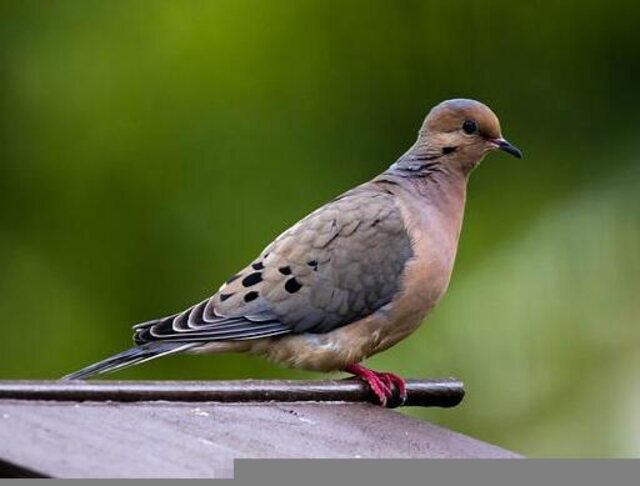
- Length: 9.1-13.4 in (23-34 cm)
- Weight: 3.4-6.0 oz. (96-170 g)
- Wingspan: 17.7 in (45 cm)
- Scientific Name: Zenaida macroura
- Frequency of Occurrence: 38.39%
- Maps: Range Map – Sightings Map
- Sounds: Calls and Sounds
- Where To Find Them: The mourning dove is a migratory bird that can be found in many different locations in Tennessee. They are known to live in areas with plenty of water, such as rivers and lakes. The birds are also known to live in green spaces, such as parks and forests.
- How to Attract Them: There are many things you can do to attract mourning doves to your yard, but one of the simplest and most effective is to use a platform feeder with sunflower seeds, safflower seeds, and cracked corn. These birds love to eat protein-rich foods and will flock to a feeder that includes these items.
General Information: The Mourning Dove is one of the most widely distributed birds in the United States and Canada. Its range extends from southeastern Alaska to the Atlantic Coast and south to Central America and the Caribbean. In the winter, its range extends further south into the Caribbean, Central America and northern South America. The Mourning Dove can be found in a variety of habitats including open woodlands, farmlands, grasslands, deserts and urban areas.
They prefer open, grassy areas with scattered trees and shrubs. They are also commonly found along roads, hedgerows, and backyard bird feeders. Mourning Doves feed on a variety of foods including seeds, fruits, insects, and some grains. They prefer grass and weed seeds, such as millet and sunflower, which they eat by flicking their tongues to capture the seeds.
They also eat fruits such as cherries, grapes, and berries. Insects, such as grasshoppers, caterpillars, and beetles, are also part of their diet. In the spring and summer, Mourning Doves may also consume flower nectar and tree sap. During the winter months, they may search for food on the ground, especially when snow is present. They may also search in bird feeders for grain, sunflower seeds, and suet.
Read more about this bird: 25 Fun Facts About Mourning Doves (A Complete Guide!)
Red-bellied Woodpecker
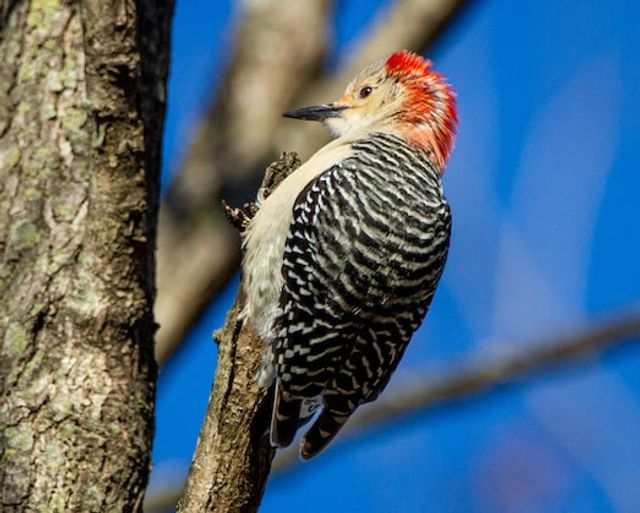
- Length: 9.4 in (24 cm)
- Weight: 2.0-3.2 oz. (56-91 g)
- Wingspan: 13.0-16.5 in (33-42 cm)
- Scientific Name: Melanerpes carolinus
- Frequency of Occurrence: 37.31%
- Maps: Range Map – Sightings Map
- Sounds: Calls and Sounds
- Where To Find Them: The Red-bellied Woodpecker is a common sight in Tennessee. They are found throughout the state, but their favorite spots are around trees and other tall vegetation. They can also be found in towns and suburbs, but tend to avoid heavily populated areas.
- How to Attract Them: Attracting the Red-bellied Woodpecker to your feeder is not as difficult as you may think. Most of all, provide an abundant supply of fresh, high-quality food. Choose a feeder that offers a variety of foods, such as a tube feeder with sunflower seeds, peanuts or suet feeder with peanut butter suet. Place the feeder in an area where the bird can see it from a distance.
General Information: The Red-bellied Woodpecker (Melanerpes carolinus) is a medium-sized woodpecker found in the eastern United States and parts of Canada. It has a broad distribution range that stretches from southern Canada, down the east coast of the United States, and into Central America.
The Red-bellied Woodpecker is found in a variety of habitats, from open woodlands and old fields to suburban and urban areas. They prefer mature forests, but can be found in parks and yards. The Red-bellied Woodpecker mainly feeds on insects, such as ants and beetles, as well as nuts, fruits, and berries.
It also eats seeds, suet, and other items found in bird feeders. In the spring, they can be observed drumming on trees as they search for food and mates. The Red-bellied Woodpecker is a valuable asset to the woodlands it inhabits, as it plays a key role in controlling insect populations and dispersing seeds.
Read more about this bird: How to Attract Red-bellied Woodpeckers to your Yard?
Downy Woodpecker

- Length: 5.5-6.7 in (14-17 cm)
- Weight: 0.7-1.0 oz. (21-28 g)
- Wingspan: 9.8-11.8 in (25-30 cm)
- Scientific Name: Picoides pubescens
- Frequency of Occurrence: 35.56%
- Maps: Range Map – Sightings Map
- Sounds: Calls and Sounds
- Where To Find Them: The Downy Woodpecker is a common bird in Tennessee during the winter. This bird can be found in a variety of locations, but they are most commonly seen in forests and woodlands.
- How to Attract Them: Downy Woodpeckers are one of the very common birds during the winter months. They are attracted by bird feeders that have black oil seeds and millet in them. You may also try including peanuts as another food source.
General Information: The Downy Woodpecker (Picoides pubescens) is a species of woodpecker found throughout the United States and Canada, Mexico and parts of Central America, as well as parts of the Caribbean Islands and northern South America. It’s also distributed in a few parts of Europe and Asia. These birds prefer to live in deciduous and coniferous forests, and are commonly found in parks and gardens.
As opportunistic feeders, they eat a variety of insects, grubs, berries, and nuts. They will also feed on sap, suet, and other food found at bird feeders. The Downy Woodpecker has an extensive distribution range, spanning across most of North America and into parts of South America and Europe. Its preferred habitats are deciduous and coniferous forests, but it is also found in parks and gardens.
It is generally found at lower elevations near bodies of water, such as lakes, rivers, and streams. Their diet consists of a variety of insects, grubs, and berries, as well as nuts, seeds, and suet. They often feed on sap from trees, using its bill to drill holes into the tree and extract the sap. They also feed on nuts and seeds, as well as fruits and berries. During the winter months, they may feed on food found at bird feeders.
Read more about this bird: How to Attract Downy Woodpeckers to Your Yard? (Easy!)
Northern Mockingbird

- Length:8.3-10.2 in (21-26 cm)
- Weight: 1.6-2.0 oz (45-58 g)
- Wingspan: 12.2-13.8 in (31-35 cm)
- Scientific Name: Mimus polyglottos
- Frequency of Occurrence: 34.73%
- Maps: Range Map – Sightings Map
- Sounds: Calls and Sounds
- Where To Find Them: Northern mockingbirds can be found in a variety of locations in Tennessee during the winter. These birds are often seen near water sources such as lakes, ponds, and waterways. They are also commonly spotted near forests and other areas with large amounts of trees.
- How to Attract Them: One way to do this is by providing them with food they prefer, like platform feeders with mealworms. Mealworms are a high-quality protein and contain essential fatty acids that the mockingbirds need.
General Information: The Northern Mockingbird (Mimus polyglottos) is a species of passerine bird native to North America. It has a range that stretches from southern Canada throughout the United States and down to Mexico, Central America and the Caribbean. They prefer to inhabit open woodlands and shrublands, but can also be found in urban areas. It is an adaptable species and can survive in a variety of habitats.
Northern Mockingbirds are omnivorous, and they will feed on a variety of insects and worms, as well as fruits and berries. They often frequent backyards and other areas that offer a variety of food sources. They will also eat birdseed and will often be seen perched on bird feeders, eating sunflower seeds and other bird food.
Northern Mockingbirds are known for their vocal abilities; they can mimic the calls of other birds, as well as the sound of car alarms and other human-made noises. They are also known for their territorial nature, often chasing away other birds who come too close to their nest. Northern Mockingbirds are a common sight throughout their range and are an important species in many ecosystems.
Read more about this bird: How to Attract Mockingbirds to your Yard? (Expert Tips)
Song Sparrow
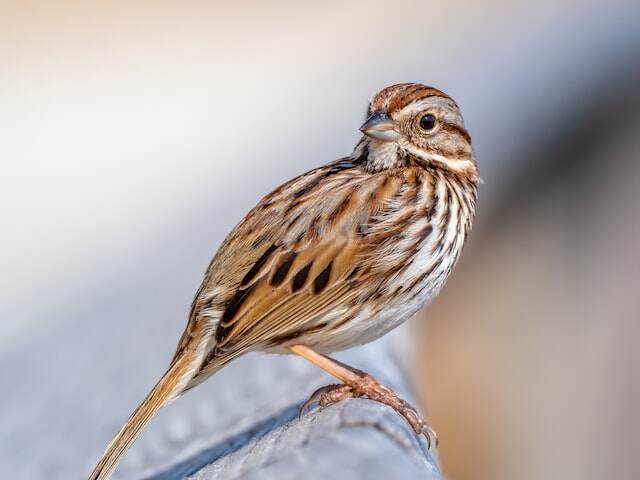
- Length:4.7-6.7 in (12-17 cm)
- Weight: 0.4-1.9 oz. (12-53 g)
- Wingspan: 7.1-9.4 in (18-24 cm)
- Scientific Name: Melospiza melodia
- Frequency of Occurrence: 33.11%
- Maps: Range Map – Sightings Map
- Sounds: Calls and Sounds
- Where To Find Them: Song Sparrows are abundant in Tennessee during the winter. These birds can be found statewide, but are more common in the southern and eastern parts of the state. Locations where they can be seen include open areas such as fields, marshes, parks and yards, as well as urban areas such as neighborhoods, gardens and commercial areas.
- How to Attract Them: A tube feeder filled with mixed millet and sunflower seeds is an excellent way to attract song sparrows. These small birds prefer to eat small seeds, and will eagerly swoop down to grab a bite from your feeder.
General Information: The Song Sparrow is a medium-sized sparrow that is native to North America and is widely distributed throughout the continent. Its range extends from Alaska and northern Canada, south to Central America and the Caribbean. It is also found in some parts of Europe, Asia, and Africa. The Song Sparrow lives mainly in open grasslands, meadows, and along the edges of forests, wetlands, and fields.
It is also found in urban and suburban parks and gardens. The Song Sparrow has a wide variety of foods that it feeds on, including insects, spiders, snails, seeds, fruits, grains, and occasional small rodents. It forages on the ground or in low vegetation, and also eats from bird feeders. It prefers to feed on insects when it can, but also readily eats seeds and fruits, which is why it is attracted to bird feeders.
The Song Sparrow is a common and widespread species, and is a familiar bird to many people. It is an attractive and attractive bird, with its gray-brown upperparts, streaked breast, and yellowish-white underparts. It is also known for its cheerful and melodious song, which is why it is called the Song Sparrow.
Read more about this bird: How to Attract Sparrows to your Backyard? (Like A Pro)
White-throated Sparrow
- Length: 6.3-7.1 in (16-18 cm)
- Weight: 0.8-1.1 oz. (22-32 g)
- Wingspan: 7.9-9.1 in (20-23 cm)
- Scientific Name: Zonotrichia albicollis
- Frequency of Occurrence: 32.79%
- Maps: Range Map – Sightings Map
- Sounds: Calls and Sounds
- Where To Find Them: The White-throated Sparrow is a common resident throughout most of Tennessee, but they are not as common in the more mountainous regions. They can be found in a variety of habitats including open woods, urban areas, and suburban gardens.
- How to Attract Them: This bird loves to feed on sunflower seeds, so providing a feeder with this type of seed is a great way to attract them. Simply place a feeder full of sunflower seeds in an area where the White-throated Sparrow is known to frequent, and watch them flock in.
General Information: The White-throated Sparrow (Zonotrichia albicollis) is a medium-sized sparrow with a wide distribution range across North America. It is a permanent resident in the northeast and eastern Canada and a migratory species in the Midwest and western Canada.
Its main habitats are deciduous and coniferous forests, shrubland, grassland, and urban gardens. Its diet consists mainly of seeds, grains, and insects. It tends to feed on the ground or in low vegetation and can often be seen foraging in large flocks. It can also be observed foraging in trees for insects, particularly in the spring and summer months.
During the winter months, it feeds on buds and fruits, as well as the seeds of grasses and weeds. The White-throated Sparrow is an important species in North America, providing valuable sustenance to a wide variety of birds, mammals, and other species.
House Finch
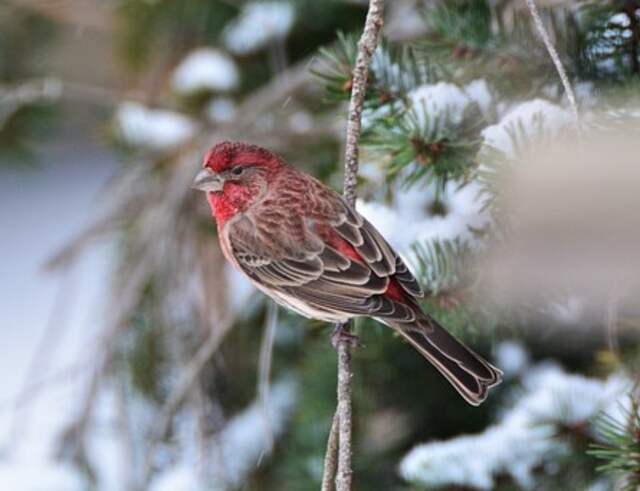
- Length: 5.1-5.5 in (13-14 cm)
- Weight: 0.6-0.9 oz. (16-27 g)
- Wingspan: 7.9-9.8 in (20-25 cm)
- Scientific Name: Haemorhous mexicanus
- Frequency of Occurrence: 31.64%
- Maps: Range Map – Sightings Map
- Sounds: Calls and Sounds
- Where To Find Them: House finches are a common sight in Tennessee during the winter. These small birds can be found in many locations, but some of the most common spots include yards, parks, and gardens.
- How to Attract Them: One of the simplest ways is to provide them with a tube feeder filled with black oil sunflower seeds. Doing so will help keep these birds happy and healthy, while providing them with a tasty source of food.
General Information: The House Finch (Haemorhous mexicanus) is a small, social finch native to North America. Its range stretches from the southern parts of Canada to northern Mexico and the US, with the highest populations being found in California and the eastern parts of the US. The House Finch is a common backyard bird and is easily recognizable with its bright red, brown, gray and black plumage. Its main habitat consists of open woodlands, brushy fields, farmlands, and suburban gardens.
They are also often seen in urban areas, where they feed on bird feeders and perch on balconies and windowsills. The House Finch feeds mainly on seeds, buds, fruits, and insects. They are particularly fond of sunflower seed and other seeds found in bird seed mixes. They also eat small insects such as aphids, caterpillars and spiders. During the breeding season, the male House Finch feeds his mate insects and other prey items to provide the extra nutrition needed for egg production.
The House Finch is a very adaptable bird and can be found in a variety of habitats. They are often seen in large flocks, and their range is expanding as they adapt to human activity. In the winter, they may migrate southward, though some populations have become partially or fully sedentary. The House Finch is a very popular backyard bird, and its bright colors make it a beautiful addition to any garden.
Read more about this bird: How to Attract House Finch to your Yard? (Easy & Fast)
Eastern Bluebird
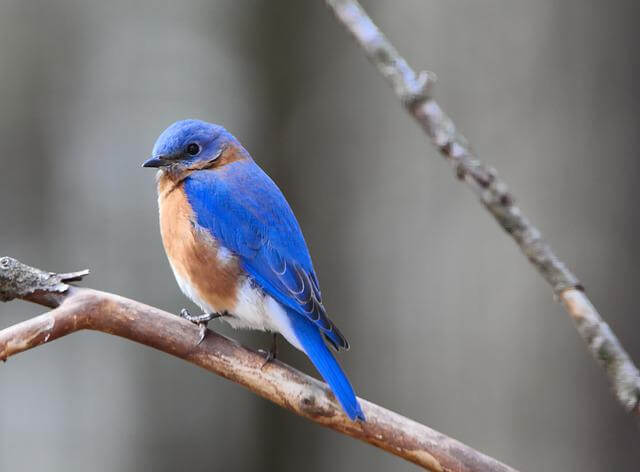
- Length: 6.3-8.3 in (16-21 cm)
- Weight: 1.0-1.1 oz. (28-32 g)
- Wingspan: 9.7-12.5″in. (25-32 cm)
- Scientific Name: Sialia sialis
- Frequency of Occurrence: 31.15%
- Maps: Range Map – Sightings Map
- Sounds: Calls and Sounds
- Where To Find Them: The birds prefer to live in wooded areas with lots of trees and shrubs, but they’ll also nest in man-made structures like churches or utility poles. When winter arrives, Eastern Bluebirds migrate to areas where there is plenty of food and shelter. Some popular spots include suburban gardens, pine forests, and agricultural pastures.
- How to Attract Them: Many bird enthusiasts know that the Eastern Bluebird is a beautiful bird to see. But many people don’t know how to attract them. One way to do this is by using a platform feeder with mealworms. Mealworms are high in protein and fat, which can be appealing to birds who need those nutrients for their diets.
General Information: The Eastern Bluebird (Sialia sialis) is a small thrush found throughout much of North America, ranging from Southern Canada to the Gulf Coast of Mexico. They prefer open spaces such as open fields, meadows, and pastures, and are often found along forest edges, hedgerows, and other semi-open areas.
They are also commonly found in residential areas, particularly in parks and suburban backyards. The Eastern Bluebird’s diet consists mainly of insects, particularly grasshoppers, beetles, caterpillars, and spiders; they also consume berries and other fruit.
During the winter months, they will also eat suet and mealworms provided by bird feeders. They will also feed on the ground, often in areas of low vegetation, where they can easily find their prey. During the breeding season, they will also feed on a variety of small fruits, including elderberries, blueberries, and cherries.
Read more about this bird: 68 Fun Facts About Eastern Bluebirds (You Didn’t Know!)
American Goldfinch
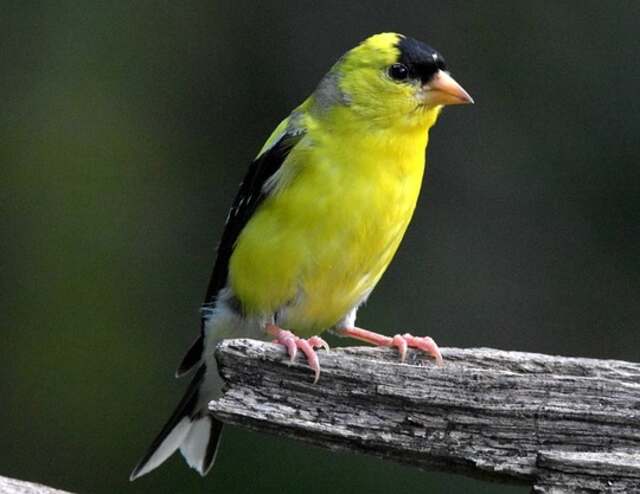
- Length: 4.3-5.1 in (11-13 cm)
- Weight: 0.4-0.7 oz. (11-20 g)
- Wingspan: 7.5-8.7 in (19-22 cm)
- Scientific Name: Spinus tristis
- Frequency of Occurrence: 29.52%
- Maps: Range Map – Sightings Map
- Sounds: Calls and Sounds
- Where To Find Them: American Goldfinch are one of the most common birds in Tennessee during the winter months. They can be found throughout the state, but some popular locations include areas around Nashville and Memphis.
- How to Attract Them: American Goldfinch are one of the most commonly seen birds in bird feeders, but there is one way to attract them even more: use a tube feeder with nyjer or sunflower seeds. Nyjer and sunflower seeds are great for attracting these small birds because they are high in protein and low in fat.
General Information: The American Goldfinch (Spinus tristis) is a small passerine bird native to North America. It is found year-round across most of continental United States and Canada, as well as parts of Mexico, Central America and the Caribbean. Its range extends eastwards to the western coast of Europe, with occasional sightings in the United Kingdom. The American Goldfinch is a sociable bird and can be found in small flocks in open areas such as meadows, pastures, and agricultural fields.
They are especially common in suburban areas, where they are attracted to bird feeders and gardens. The American Goldfinch feeds on a wide variety of plants, including small seeds and fruits. In the spring and summer, they feed on the seeds of thistles and other plants, including ragweed, dandelion, and sunflower. They also eat insects and spiders, and are known to feed on buds and flowers.
In the winter, they rely heavily on tree seeds such as those of the pine, spruce, and fir. In addition to these, American Goldfinches will also eat suet, millet, and other types of birdseed from bird feeders. The American Goldfinch is a beautiful and iconic bird of the North American continent. Their bright yellow plumage and cheerful song make them a welcome sight in any backyard or field.
Read more about this bird: Interesting American Goldfinch Facts You Need to Know!
European Starling
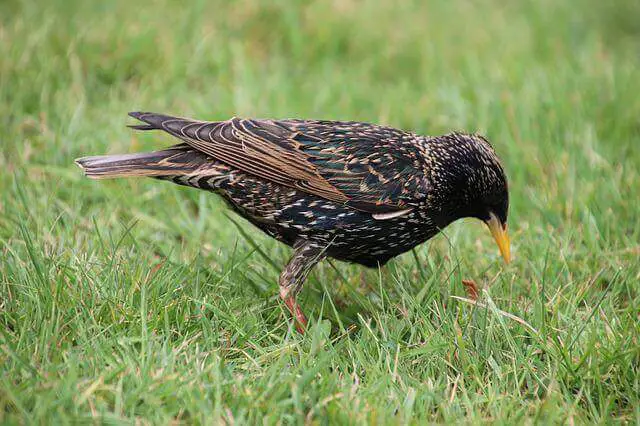
- Length: 7.9-9.1 in (20-23 cm)
- Weight: 2.1-3.4 oz. (60-96 g)
- Wingspan: 12.2-15.8 in (31-40 cm)
- Scientific Name: Sturnus vulgaris
- Frequency of Occurrence: 28.43%
- Maps: Range Map – Sightings Map
- Sounds: Calls and Sounds
- Where To Find Them: European Starlings are common in Tennessee during the winter months. They can be found in a variety of locations, but are most commonly found in suburban and rural areas.
- How to Attract Them: One way to attract European starlings to your yard is by using a platform feeder with mealworms or sunflower seeds. These birds are attracted to bright colors, so make sure the feeder is brightly colored and has a variety of foods available. You can also scatter bird seed on the ground around the feeder for added attraction.
General Information: The European Starling (Sturnus vulgaris) is a species of starling that is native to much of Europe and western Asia. This species is highly adaptable and has expanded its range to include North America, as well as parts of Africa, Australia, and New Zealand. The range of the European Starling is now one of the most widespread of any bird species.
The European Starling prefers open habitats such as fields, pastures, and grasslands, but can also be found in woodlands, parks, and urban areas. This species is also highly migratory and will often travel quite long distances in search of food, breeding grounds, and wintering grounds.
The European Starling is an omnivorous species, meaning that it will feed on both plants and animals. Some of their most common foods include insects, fruits, grains, and seeds. They will also feed on eggs, small mammals, and carrion. During the breeding season, these birds will eat more insects, which are necessary for feeding their young. They will also forage for food on the ground or in shallow waters.
Read more about this bird: How To Attract European Starlings To Your Yard Fast?
Dark-eyed Junco
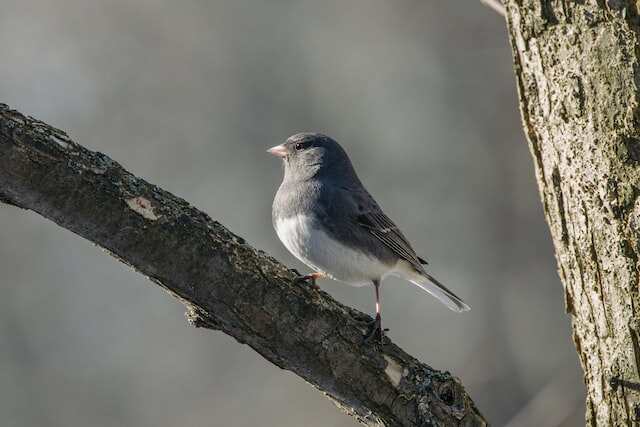
- Length: 5.5-6.3 in (14-16 cm)
- Weight: 0.6-1.1 oz. (18-30 g)
- Wingspan: 7.1-9.8 in (18-25 cm)
- Scientific Name: Junco hyemalis
- Frequency of Occurrence: 23.01%
- Maps: Range Map – Sightings Map
- Sounds: Calls and Sounds
- Where To Find Them: This bird is especially common in the Appalachian Mountains, but can also be found in other scattered locations throughout Tennessee. The Dark-eyed Junco is a winter visitor to Tennessee and will typically stay around until late February or early March.
- How to Attract Them: Looking to attract a Dark-eyed Junco to your backyard? Try using a platform feeder with hulled sunflower seed, white proso millet, and cracked corn. These ingredients create a fragrant and nutritious diet that will lure these hardy birds in droves.
General Information: The distribution range of the dark-eyed junco (Junco hyemalis) is mostly in the Northern and Central United States, as well as a few isolated pockets in the southwestern and southeastern regions. The populations are generally scattered throughout these areas, but they do have some fairly dense concentrations in certain areas.
For instance, there are large populations in the Great Lakes region, as well as in some parts of New England. Outside of these more heavily populated areas, however, their distributions are much more patchy. he Dark-eyed Junco is a small bird that resides in various habitats throughout North America.
Preferred habitats include deciduous and coniferous forests, shrubby areas, and rural gardens. These birds are mainly nocturnal and are most active at dawn and dusk. The Dark-eyed Junco is a social bird that nests in colonies of up to 16 individuals. Some of its favorite foods include seeds, insects, and other small invertebrates.
Read more about this bird: Fun Facts About Dark-eyed Juncos
White-breasted Nuthatch
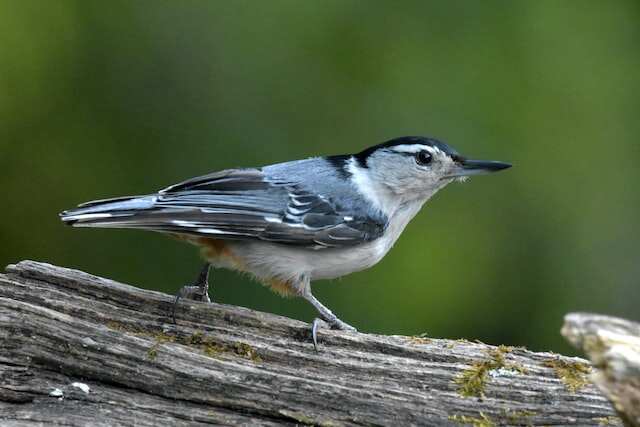
- Length: 5.1-5.5 in (13-14 cm)
- Weight: 0.6-1.1 oz. (18-30 g)
- Wingspan: 7.9-10.6 in (20-27 cm)
- Scientific Name: Sitta carolinensis
- Frequency of Occurrence: 23.88%
- Maps: Range Map – Sightings Map
- Sounds: Calls and Sounds
- Where To Find Them: The white-breasted nuthatch is a common bird found in Tennessee during the winter. They can be found in a variety of locations, but are most commonly spotted in areas with large trees and brushy areas.
- How to Attract Them: If you’re looking to attract a white-breasted nuthatch to your yard, one option is to use a platform feeder with sunflower seeds. These birds are attracted to bright colors and can be difficult to lure with regular bird seed. Alternatively, offer nuts or mealworms.
General Information: The White-breasted Nuthatch is a small, acrobatic songbird that can be found in most parts of the United States and Canada. With its white chest and dark blue-gray back, this species of nuthatch stands out among its other nuthatch relatives. These birds are mainly found in deciduous forests, parks, and suburban areas. The White-breasted Nuthatch is omnivorous, feeding on insects, seeds, and nuts. It uses its sharp bill to pry open nuts and extract the seed inside.
It also uses its beak to scrape bark and search for insects hidden beneath. The White-breasted Nuthatch is an active bird and is often seen walking upside down on the trunks of trees. It will climb up and down the trunk of a tree or scramble through the branches in search of food. This species is also known for its loud, nasal “yank-yank” call and its “tee-chew-chick” song. The White-breasted Nuthatch is a social species and will form small flocks during the winter months.
They are also known for their cooperative breeding behavior. In the spring, several female nuthatches will join the same breeding pair to help with nesting and raising the chicks. The White-breasted Nuthatch is a fascinating bird and an important part of backyard birding. Its unique behavior and vocalizations make it a joy to watch and to listen to. The White-breasted Nuthatch is an important species to help maintain the balance of the ecosystem and should be protected and respected.
Read more about this bird: How to Attract Nuthatches to your Backyard? Expert Tips!
Related Post:


